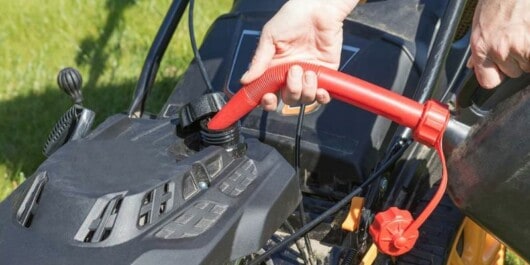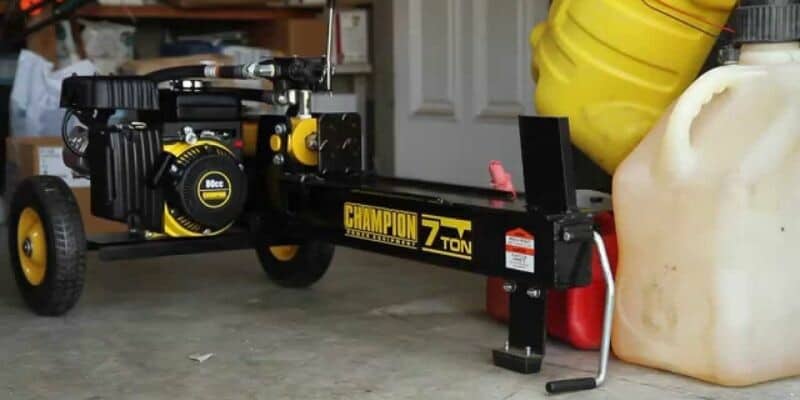Are you a log splitter user looking to fuel up your machine but don’t know if you could use mixed gas? If so, then you have definitely landed at the right blog.
Do log splitters take mixed gas is a question that almost every gas log splitter user has at some point. The answer to that is no, you cannot mix different types of gases as this could be harmful to the machine. Adding mixed gas to a log splitter shouldn’t be a common occurrence. While you can mix gas when you’re doing it in smaller quantities, doing so in large amounts will potentially gum up the spark plug, damage it, and result in lowered performance.
In this article, you’ll get to know all about what type of gas log splitters use, do log splitters take mixed gas, should you add a stabilizer to the fuel, how to mix the gas for log splitters, and more. Continue reading to get all the answers that you are looking for.
What kind of gas does a log splitter use?
A log splitter usually runs on the normal gas that you put in your vehicle. If you are heading to the gas station, you should fill up your fuel container with unleaded gas, and you will be able to use it in your log splitter. If you have already got other gas-powered equipment like chainsaws or lawnmowers, then chances are that your log splitter will run on the same type of gas.
Of course, it will be worth checking the user manual for your gas-powered log splitter if you want to be 100% sure. However, it is highly likely that your log splitter will be using anything other than normal gas. No other kind of gas will burn efficiently enough to give the log splitter the ample power it needs for splitting up the wooden logs.
Do log splitters take mixed gas?
Mixing different types of gases can end up destabilizing the fuel, reducing its efficiency while also affecting the engine’s performance. The smartest choice would be to stick with the gas type and refueling intervals recommended by the log splitter manufacturer. Moreover, you should visit your local dealer for regular maintenance checkups for your machine.
However, you can mix gas when you are doing it in smaller quantities. If you are doing so in large amounts, it will potentially gum up the spark plug, damage it, and result in lowered performance.

You should not be using diesel gas in your log splitter unless it is marketed as having a diesel motor. This is quite rare. If you are trying to put diesel gas in a non-diesel engine, you will end up breaking your log splitter. While this isn’t always necessary, it is recommended that you should use a gas that has low ethanol content.
While gas that contains ethanol will certainly burn a little bit cleaner, it will damage the engine to an extent. The engines in a gas-powered log splitter happen to be a bit more sensitive to ethanol. If you are looking to ensure the longevity of the log splitter, you will want to put as little ethanol into it as you can.
Of course, having low ethanol gas will mean that it will have a longer shelf life. As most people will not be using their splitters frequently, they will have a bit of gas left over. It’ll be good to know that you can grab an old gas container and still be confident that you’ll be able to pour the gas into your log splitter.
Should you be adding a stabilizer to the fuel?
It isn’t necessary that you should add a stabilizer to the fuel before you start pouring it into your log splitter. However, most people choose to do this. Fuel stabilizers will help in preventing oxidation. Oxidation will never be good for the motor in your log splitter.
A decent fuel stabilizer will help that fuel to burn a bit cleaner. This will be important, after all, you will be using a fuel with low ethanol content. At least, this is what you should be doing.
A fuel stabilizer will also help make things a bit easier, least, for you when you’re starting up your gas-powered log splitter. If you’re experiencing any issues getting your gas-powered log splitter to run, a bit of fuel stabilizer will do the trick.
How to mix the gas for your log splitters?
Most modern-day log splitters use 4-cycle engines. However, some of the models still use a 2-cycle or 2-stroke engine. For those log splitter users who do, it’ll be important that you know how to mix the proper amount of oil with gas.
Pouring too much oil in the mix will produce the dirty cloud of smoke that you will likely come to know. You don’t want to smoke out the neighborhood when you begin to power up your machine. Mixing a concoction of oil and gas isn’t necessarily easy in freezing temperatures while you are wearing gloves. It is recommended that you should follow these steps before you’re ready to split wooden logs.
Step 1: Separate your stash
Once you’ve added engine oil to your gas can, you will not be able to rinse it out. It is recommended that you should buy two gas cans for this reason.
First, you need to fill a 5-gallon gas can with regular unleaded gasoline. You will be able to use this gas for your log splitter, lawnmower, or any other power equipment. After that, pour 2 gallons of gas into a separate gas can, dedicate to your 2-stroke mixed fuel.
Step 2: Order extra oil
You definitely wouldn’t want to be running to a hardware store during a blizzard. Most log splitters come with a bottle of oil that is good for a set amount of gas. However, it wouldn’t be enough to get you through the winter months. It is recommended that you should order a six-pack of 2-cycle engine oil instead. While it sounds excessive, the oil contains enough fuel stabilizer for keeping it fresh.
Step 3: Add the oil to the gas
2-cycle engines require one of two types of fuel – a gas/oil mixture of either 40:1 or 50:1. You should remember to check the owner’s manual for your specific model and use a gas/oil mixture calculator before you mix the fuel.
Finally, you should add the appropriate amount of 2-stroke oil (usually two 2.6-ounce bottles) to the 2-gallon gas can. You should shake it thoroughly and then pour it into your log splitter’s gas tank.
What are the benefits of using pre-mixed fuel?
In case you don’t want to deal with measuring your mixture ratios or having your gloves and other clothing smell like gasoline, getting pre-mixed fuel will be an instant solution. All that you’ll need to do is open, pour, and you’ll be good to go.
Pre-mixed 2-cycle oil is pretty easy to use, and it’ll guarantee the correct ratio of gasoline and oil. Moreover, unopened pre-mixed fuels also tend to have a shelf-life of up to 3 years. Once it is opened, it’ll last two winters. Once you’ve topped off your log splitter, it’ll be time to put it to use.
FAQs
Do log splitters take regular gas?
Yes, log splitters can run on regular gas. They can run on the same gas that you put into most vehicles and hand-held tools. However, you might want to pay attention to the ethanol content of the gas, but it isn’t necessary. As long as you aren’t using diesel, then it should work in the log splitter.
What is the best oil for your log splitter?
AW22 or 32 Hydraulic oil is generally recommended for log splitters. Automatic transmission fluid can be easily substituted and can only be used instead of hydraulic oil if the temperatures are below 32 degrees F.
Can you use synthetic oil in your log splitter?
AMSOIL Synthetic Hydraulic Oil will be able to deliver a noticeable upgrade over regular hydraulic oil. This type of oil will also optimize the performance and wear protection of your log splitter’s hydraulic system.


